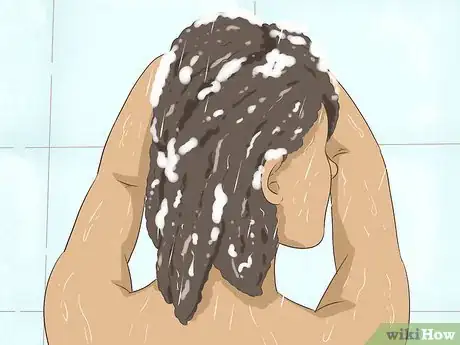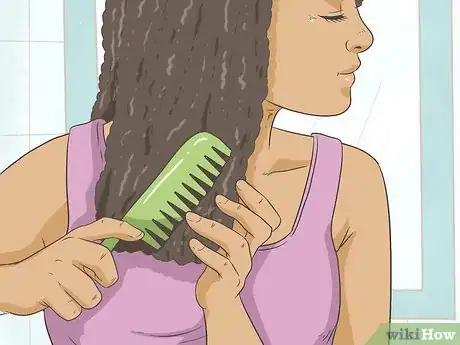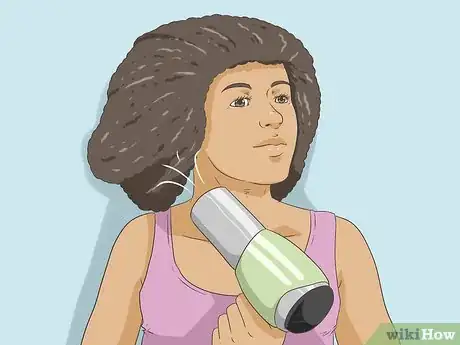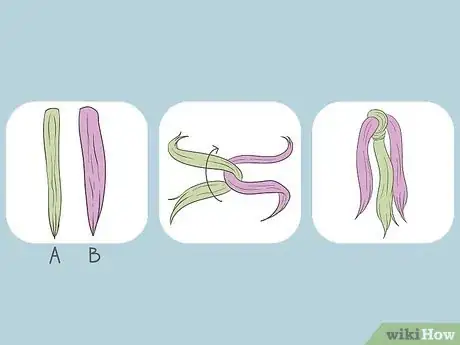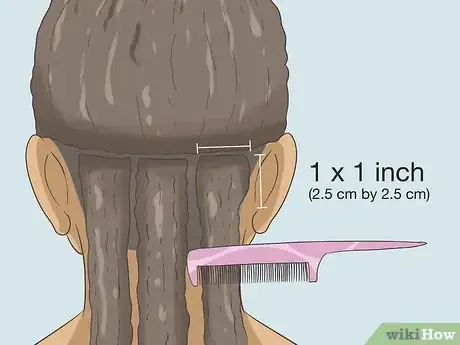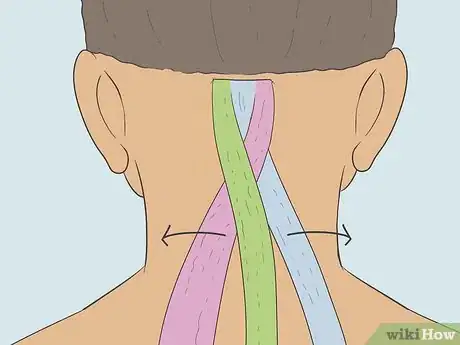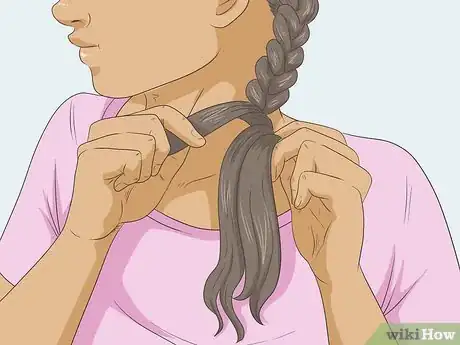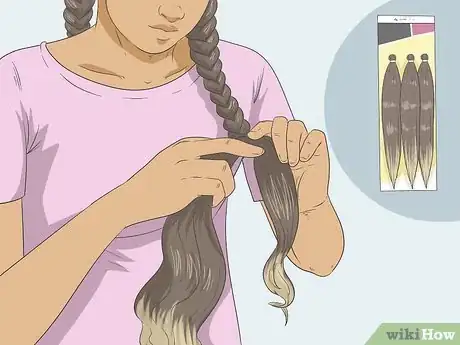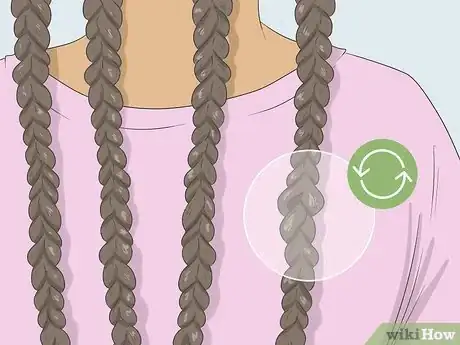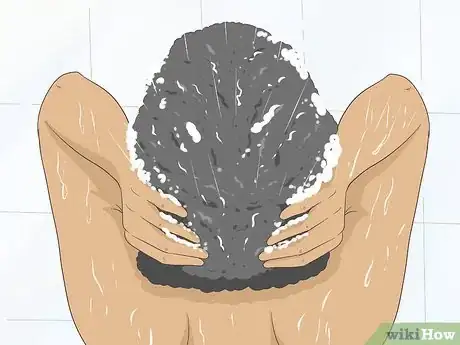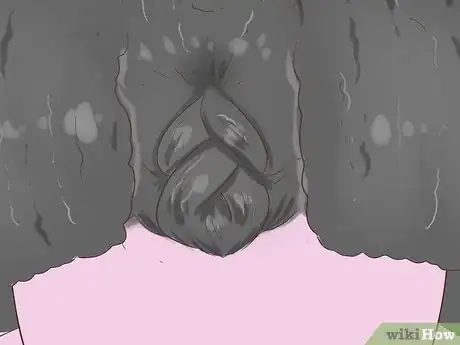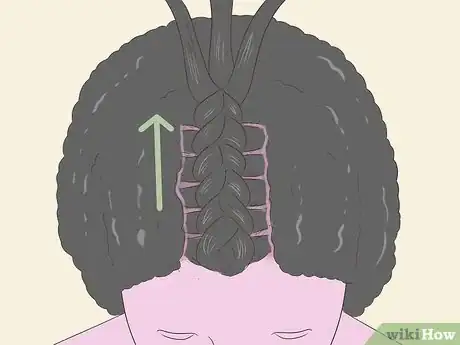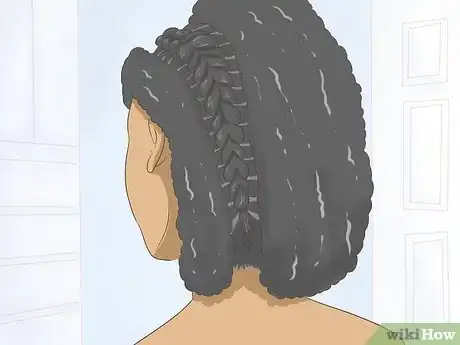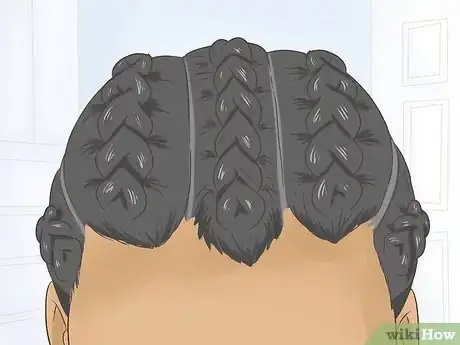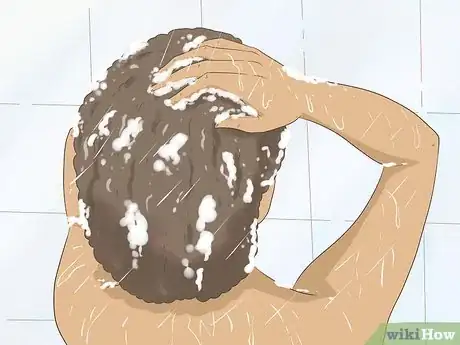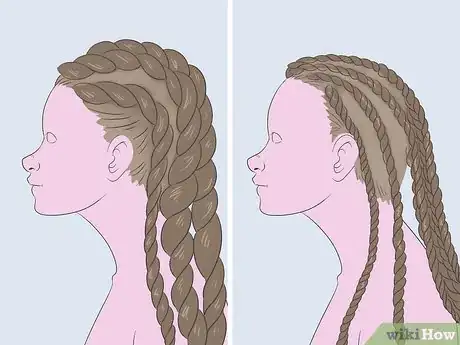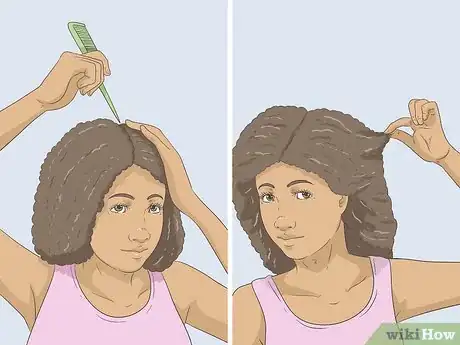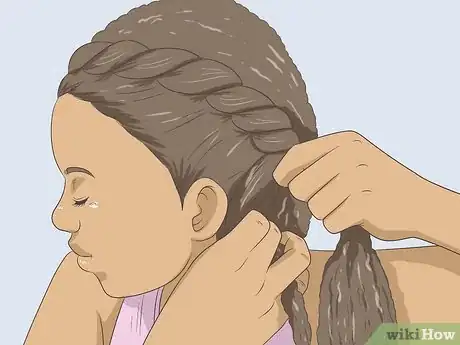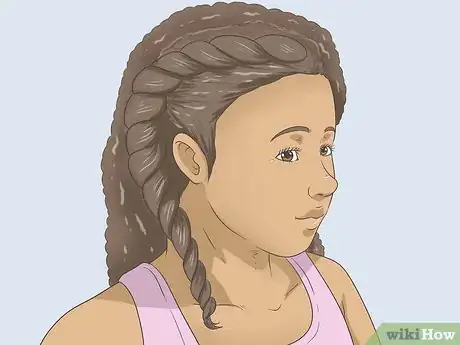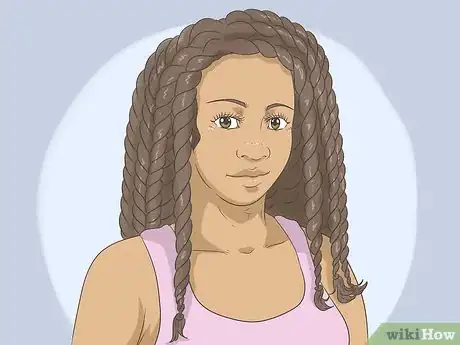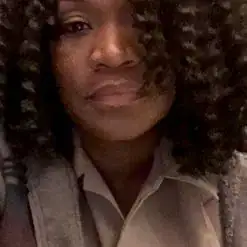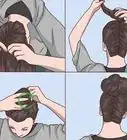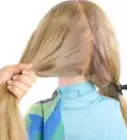This article was co-authored by Ndeye Anta Niang. Ndeye Anta Niang is a Hair Stylist, Master Braider, and Founder of AntaBraids, a traveling braiding service based in New York City. Ndeye has over 20 years of experience in African hair including braiding box braids, Senegalese twists, crochet braids, faux dread locs, goddess locs, kinky twists, and lakhass braids. Ndeye was the first female of her tribe in Africa to move to America and is now sharing her knowledge of African braids passed on from generation to generation.
This article has been viewed 565,281 times.
Because of its natural thickness and fullness, braiding African hair can be a challenge, but it's possible with a little help. Rope braids and cornrows are beautiful, classic styles that you can do without going to a salon. Be gentle with your hair, and take your time! The results will be well worth it.
Steps
Creating Box Braids
-
1Wash and condition your hair. Start by washing your hair as per usual, and then use a deep conditioner to help soften your strands. Leave the conditioner on your hair for the amount of time recommended on the bottle, then rinse it out with cool water.[1]
- To minimize dryness and frizz, use a gentle, sulfate-free shampoo.
-
2Detangle your hair. When you’ve rinsed your conditioner out, use a wide-tooth comb to brush out all the tangles, starting from the ends and working towards the roots. For even gentler detangling, use your fingers to tease out any knots and tangles.[2]Advertisement
-
3Blow-dry your hair to relax and defrizz your curls. Use your hairdryer on “low” to blow out your curls, so that they are almost completely dry. Brush out your hair once more to make sure there are no knots, and then you’re ready to start your braids.
- Blow-drying your hair will help stretch and relax the curls, reducing frizz and making the hair easier to manage during the braiding process.
-
4Prepare your packages of braiding hair. Box braids use ‘braid hair’ – synthetic hair strands that are very long – to fill in the space on your scalp and give you plenty of fullness in your braids. Take each chunk of hair out of the packages individually, and hold them in the center, cutting off the elastic bands holding it together. With a grip on the center and the 2 tail ends of the hair hanging down, begin pulling the strands on 1 side of the hair. This will give the ends of your hair a more natural look, otherwise the packaged hair is blunt-cut straight across and your braids will look a bit unnatural when you’re finished.
- Choose your braid hair in a color similar to your own, and get at least 2 large packages. The longer and thicker you want your braids to be, the more packages of braid hair you will need. If you want shorter braids, use fewer packages and cut the braid hair into halves or thirds.
- When you’re pulling the hair, gently tug at small strands rather than big portions of hair.
- Run your fingers through the hair when you’re finished evening out the ends to remove any knots that might have shown up.
-
5Get a strand of braiding-hair ready for braiding. Section off your first piece of braiding hair into a strand that is about 2–3 inches (5.1–7.6 cm) wide. Then, separate off ⅓ of this section. You should be holding 2 sections with 1 that is twice as thick as the other. Wrap the smaller strand around the larger one, so that the tail ends are facing opposite directions (like ‘><’). Take the smaller strand and grab it at the center where it is intertwined with the first strand. Carefully twist the strand over and under, so that the 2 tail ends form a single piece that sticks out between the original tail strands.
- You should be left with 3 strands of approximately equal size, which you can hold in 1 hand.
-
6Section off your hair on your scalp for braiding. Use a rat-tooth comb to carefully section a small piece of hair on your scalp, approximately 1-inch by 1-inch (2.5 cm by 2.5 cm). It will probably be easiest to start on 1 side of your head near your hairline and work your way back, but you can start wherever you are comfortable. Use a bit of hair gel or edge control product to prepare this section, making it easier to manipulate.
- If you want to do basic box braids, you can section the hair into square “boxes.” You can also get creative and make sections in other shapes, such as diamonds or triangles.
-
7Start your first braid. Hold your braiding hair in your hand so that 1 strand is between your thumb and index finger, a second strand is between your index and middle finger, and the third strand is hanging behind the first 2. Grab the section of hair closest to your scalp with your thumb and index finger, as close to the roots as possible. To start the braid:
- Reach your empty hand around your head and grab the third strand of braiding hair hanging behind the ones gripped in your hand.
- Simultaneously pull the 3rd strand of hair under and incorporate the hair from your scalp into the section between your thumb and index finger, and twist it over in the opposite direction.
- Pull the third loose section of hair into the middle, between the other 2 sections. You should now have 3 separate strands of hair that are held tight to your scalp, with your natural hair incorporated into 1 of the sections.
-
8Braid your section of hair. With your braiding hair as close to your scalp as possible, begin braiding tightly in the traditional pattern. Alternate placing the left-most strand over the middle section, and then the right-most strand over the middle section. When you reach the end of your braid, the strands should taper out into a smaller and smaller braid. You don’t need to use an elastic band to hold it in place, as it should hold on its own.[3]
-
9Braid additional sections of hair. Repeat the same steps as aforementioned to braid the rest of your head:
- Section a 1-inch by 1-inch (2.5 cm by 2.5 cm) piece of hair from your scalp, and apply gel or edge control.
- Prepare your braiding hair and part it into 3 strands.
- Use the twisting method to combine your natural hair into your braiding hair.
- Complete the braid using a regular 3-strand method until you reach the ends.[4]
-
10Perfect each braid. As you braid, it is important to take the time to make sure they are all smooth, flexible, and even. If you notice any bulging strands or lumps in your braid, you’ll need to take it out and start over from the beginning. If your natural hair is sticking out from the strands of your braiding hair, you’ll need to remove your braiding hair and add gel or edge control to moisturize it and reduce frizz.
- You may have to re-braid the same strand multiple times in order to get it just right.
- If your braid is uneven, you may have started with sections of differing thickness. You’ll have to take out your braiding hair and re-split it into 3 even sections.[5]
Braiding Cornrows
-
1Wash and condition your hair. Because you’ll likely be leaving your hair in cornrows for several weeks straight, you want to make sure that you start with clean, well-conditioned hair.[6] Wash your hair with your regular shampoo, and then use a deep conditioner to soften it. You’ll also want to use a hair gel of some sort while you braid, to keep your hair smooth, frizz-free, and easy to control and manipulate.
-
2Decide where your part will be. Cornrows can be braided in any direction, so it is important that you decide where your part will be before you start braiding. The 2 most common part styles are either in rows from your hairline straight back to the nape of your neck, or braided in a circular motion around your head from a center part. You’ll need to use a rat-tooth comb to part your hair in the desired pattern, and to split your hair into sections for braiding.
-
3Section your hair. Fill a spray bottle with water and a little bit of olive oil and shake it well. Then, spray down the section of hair you are working with. Use your comb to separate off this section of hair in a row down your head. The smaller the part, the smaller the braid; the larger the part, the larger the braid. Use butterfly clips to hold your remaining hair in place out of your face.[7]
-
4Begin your first cornrow. Take the sectioned part of hair in 1 hand and pull a small piece from the very top (near your hairline) away from the rest of the bunch. Separate this small piece of hair into 3 sections of equal size. Start braiding these 3 pieces in the traditional braiding pattern: cross the right-most section over the middle section, then cross the left-most section over the middle section, back and forth.
-
5Add in more hair to your cornrow. The cornrows are created by braiding your sectioned hair in a French braid really close to your head. As you work down your parted section of hair, continue your braid the same way you started it. However, as you braid, grab small portions of hair from the un-braided part and incorporate them into each strand you cross over the middle section. You are essentially creating a very tiny french braid.
- As you add in hair, pull the braid tight and keep your fingers close to your head.
- Don’t braid your hair away from your head, as this will make your cornrows loose and appear funny.
-
6Finish your cornrow. When you get to the nape of your neck, you may or may not run out of hair. If your hair is short, you will finish your cornrow by twisting the ends of the braid together to secure them and prevent unravelling. If your hair is a bit longer, you will continue your cornrow past the nape of your neck in a regular braid. Twist the ends to secure the braid when you’re finished.
- You can choose to use small, clear elastic bands to hold your cornrows in place if you’re worried about the braids coming loose.
- Some people choose to put beads on the ends of each braid as a decorative detail.
-
7Cornrow the rest of your hair. Work across your scalp, sectioning out even pieces of hair and braiding them into cornrows. The process can be quite time-consuming, so don’t be alarmed if it takes several hours to complete. Make sure that each cornrow is the same size and follows the same pattern, so that it appears even and intentional across your head.
- If your hair is sticking out from your braids, it is likely not moisturized enough and your braids aren’t tight enough. Add more styling product, such as gel, edge control, pomade, or mousse, to remedy this.
- You might need help from someone to make sure that all your rows are even and parallel, especially on the back of your head.
Making 2-strand Twist Braids
-
1Wash and condition your hair. Just like with other braiding styles, your hair needs to be well-moisturized and de-tangled prior to starting your 2-strand twists. Wash your hair as per usual, and then use a deep conditioning cream to moisturize it.
- Your 2 strand twists will be easier to style if they are wet or at least slightly damp, so do not blow dry or air-dry your hair completely before styling.
- Use a comb to remove any tangles or knots that might be present.
-
2Decide on the size of your twists. There are many options when it comes to braiding your 2-strand twists. The most obvious decision you’ll need to make is how large you want your braids to be. You can do ‘micro twists,’ which use dozens of teeny-tiny braids, or you can do jumbo twists that use 1-inch (2.5 cm) sections or larger of hair.
- Small twists will last much longer than large twists, but the process is obviously more time-consuming. Decide what size you want based on your personal style and the amount of time you have to work on your hair.
-
3Prepare your first section. Use a rat-tail comb to part a section of hair to your desired size. The section of hair should be a square in shape. Rub a bit of style gel or cream through your hair and mist it with a little water and olive oil to reduce frizz and make it easier to manipulate. Use your comb to brush through this section several times, to make sure that the hair is completely smooth and tangle-free.
-
4Start twisting your first section. Split your section of hair into 2 equal strands. Begin winding them tightly away from your head in a rope-like pattern. You’ll simply wrap the strands simultaneously around each other to create a twist. To keep it tight, you’ll want to pull the twist tight to your scalp as you work.
-
5Finish your first twist. When you near the end of your strand and begin running out of hair to twist, you will need to switch to doing a 1-strand twist to secure the ends. To do this, take the 2 strands and combine them together (there shouldn’t be much hair left to do this with). Then, wrap this section around your finger many times, in the same direction you were twisting the 2 strands of hair. This will curl the ends of the hair in the same direction, securing them in place.
- This method works best if your hair is naturally curly rather than chemically relaxed or permed.
-
6Repeat the twisting process on the rest of your hair. Continue working your way across your scalp, creating your 2-strand twists. The process is the exact same for each twist, just make sure that you section off equal amounts of hair so that all your twists are the same size.
- Section a small piece of hair, comb it, and apply your gel or cream.
- Split your section into 2 equal strands.
- Wrap the strands around each other to form a rope-braid.
- Twist the ends of the 2-strand braid together to secure them and prevent the braid from unravelling.[8]
Expert Q&A
Did you know you can get expert answers for this article?
Unlock expert answers by supporting wikiHow
-
QuestionWhat are some common mistakes people make when braiding hair?
 Ndeye Anta NiangNdeye Anta Niang is a Hair Stylist, Master Braider, and Founder of AntaBraids, a traveling braiding service based in New York City. Ndeye has over 20 years of experience in African hair including braiding box braids, Senegalese twists, crochet braids, faux dread locs, goddess locs, kinky twists, and lakhass braids. Ndeye was the first female of her tribe in Africa to move to America and is now sharing her knowledge of African braids passed on from generation to generation.
Ndeye Anta NiangNdeye Anta Niang is a Hair Stylist, Master Braider, and Founder of AntaBraids, a traveling braiding service based in New York City. Ndeye has over 20 years of experience in African hair including braiding box braids, Senegalese twists, crochet braids, faux dread locs, goddess locs, kinky twists, and lakhass braids. Ndeye was the first female of her tribe in Africa to move to America and is now sharing her knowledge of African braids passed on from generation to generation.
Hair Stylist & Master Braider
-
QuestionI'm 14 yrs old and I don't know how to braid my natural hair. Usually my older sister does it, but she's going to college and won't have time for me. How can I do the braids on the side of my head with my natural hair and no synthetic hair added?
 Ashley AdamsAshley Adams is a Licensed Cosmetologist and Hair Stylist in Illinois. She completed her Cosmetology education at John Amico School of Hair Design in 2016.
Ashley AdamsAshley Adams is a Licensed Cosmetologist and Hair Stylist in Illinois. She completed her Cosmetology education at John Amico School of Hair Design in 2016.
Professional Hair Stylist After shampooing, conditioning, and drying your hair, you need to part your hair in horizontal partings since you want the braids going to the side. Make the parts as thin or as thick as you want the braids to be. Comb the hair to detangle it, take 3 small sections of hair and begin braiding. Add small pieces of hair as you continue to braid. You may need to ask for assistance with parting your hair in areas that you can’t see, and braiding in areas that you’re unable to reach.
After shampooing, conditioning, and drying your hair, you need to part your hair in horizontal partings since you want the braids going to the side. Make the parts as thin or as thick as you want the braids to be. Comb the hair to detangle it, take 3 small sections of hair and begin braiding. Add small pieces of hair as you continue to braid. You may need to ask for assistance with parting your hair in areas that you can’t see, and braiding in areas that you’re unable to reach. -
QuestionDoes my hair have to be a certain thickness to have crow rows?
 Ashley AdamsAshley Adams is a Licensed Cosmetologist and Hair Stylist in Illinois. She completed her Cosmetology education at John Amico School of Hair Design in 2016.
Ashley AdamsAshley Adams is a Licensed Cosmetologist and Hair Stylist in Illinois. She completed her Cosmetology education at John Amico School of Hair Design in 2016.
Professional Hair Stylist
Warnings
- Don't attempt to wear tight braids for an extended period of time if your hair is already very weak, brittle or damaged. Braids, when worn for long periods of time, can be damaging to the hair.⧼thumbs_response⧽
Things You'll Need
- Shampoo
- Conditioner
- Comb (fine-toothed or medium-toothed)
- Hair ties or rubber bands
- Hair clips
- A styling product, such as hair gel or edge control
References
- ↑ Ndeye Anta Niang. Hair Stylist & Master Braider. Expert Interview. 5 March 2020.
- ↑ Ndeye Anta Niang. Hair Stylist & Master Braider. Expert Interview. 5 March 2020.
- ↑ Ndeye Anta Niang. Hair Stylist & Master Braider. Expert Interview. 5 March 2020.
- ↑ https://www.youtube.com/watch?v=UrGJM0kfMeA
- ↑ https://www.youtube.com/watch?v=_30X86vl8_M
- ↑ Ndeye Anta Niang. Hair Stylist & Master Braider. Expert Interview. 5 March 2020.
- ↑ Ndeye Anta Niang. Hair Stylist & Master Braider. Expert Interview. 5 March 2020.
- ↑ https://www.youtube.com/watch?v=e5UIvm4d0Qw
- Videos provided by Breanna Rutter
About This Article
To braid African American hair, wash your hair as you normally would and apply a deep conditioner. Detangle your hair gently with a wide tooth comb, then let it air dry or blow dry it until it's lightly damp. You can then experiment with popular protective braids like cornrows, or if you want to incorporate synthetic hair into your look, consider box braids. For a less time-consuming option, give two-strand twist braids a try! For tips on sectioning your hair and perfecting your braids, read on!
